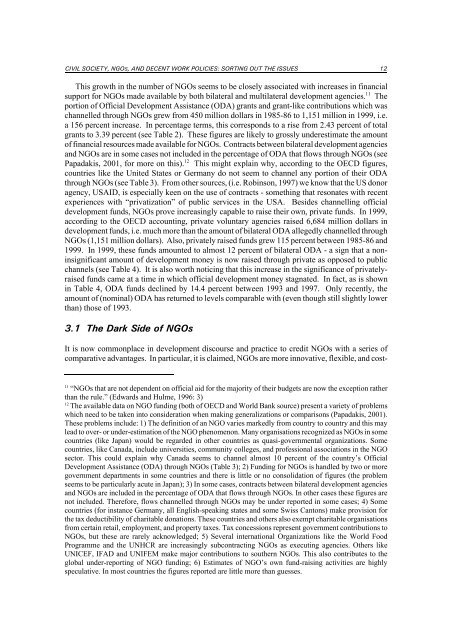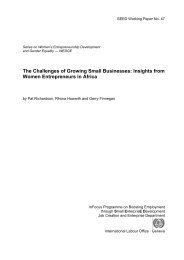Civil Society, NGOs, and Decent Work Policies: Sorting out the Issues
Civil Society, NGOs, and Decent Work Policies: Sorting out the Issues
Civil Society, NGOs, and Decent Work Policies: Sorting out the Issues
Create successful ePaper yourself
Turn your PDF publications into a flip-book with our unique Google optimized e-Paper software.
CIVIL SOCIETY, NGOS, AND DECENT WORK POLICIES: SORTING OUT THE ISSUES 12<br />
This growth in <strong>the</strong> number of <strong>NGOs</strong> seems to be closely associated with increases in financial<br />
support for <strong>NGOs</strong> made available by both bilateral <strong>and</strong> multilateral development agencies. 11 The<br />
portion of Official Development Assistance (ODA) grants <strong>and</strong> grant-like contributions which was<br />
channelled through <strong>NGOs</strong> grew from 450 million dollars in 1985-86 to 1,151 million in 1999, i.e.<br />
a 156 percent increase. In percentage terms, this corresponds to a rise from 2.43 percent of total<br />
grants to 3.39 percent (see Table 2). These figures are likely to grossly underestimate <strong>the</strong> amount<br />
of financial resources made available for <strong>NGOs</strong>. Contracts between bilateral development agencies<br />
<strong>and</strong> <strong>NGOs</strong> are in some cases not included in <strong>the</strong> percentage of ODA that flows through <strong>NGOs</strong> (see<br />
Papadakis, 2001, for more on this). 12 This might explain why, according to <strong>the</strong> OECD figures,<br />
countries like <strong>the</strong> United States or Germany do not seem to channel any portion of <strong>the</strong>ir ODA<br />
through <strong>NGOs</strong> (see Table 3). From o<strong>the</strong>r sources, (i.e. Robinson, 1997) we know that <strong>the</strong> US donor<br />
agency, USAID, is especially keen on <strong>the</strong> use of contracts - something that resonates with recent<br />
experiences with “privatization” of public services in <strong>the</strong> USA. Besides channelling official<br />
development funds, <strong>NGOs</strong> prove increasingly capable to raise <strong>the</strong>ir own, private funds. In 1999,<br />
according to <strong>the</strong> OECD accounting, private voluntary agencies raised 6,684 million dollars in<br />
development funds, i.e. much more than <strong>the</strong> amount of bilateral ODA allegedly channelled through<br />
<strong>NGOs</strong> (1,151 million dollars). Also, privately raised funds grew 115 percent between 1985-86 <strong>and</strong><br />
1999. In 1999, <strong>the</strong>se funds amounted to almost 12 percent of bilateral ODA - a sign that a noninsignificant<br />
amount of development money is now raised through private as opposed to public<br />
channels (see Table 4). It is also worth noticing that this increase in <strong>the</strong> significance of privatelyraised<br />
funds came at a time in which official development money stagnated. In fact, as is shown<br />
in Table 4, ODA funds declined by 14.4 percent between 1993 <strong>and</strong> 1997. Only recently, <strong>the</strong><br />
amount of (nominal) ODA has returned to levels comparable with (even though still slightly lower<br />
than) those of 1993.<br />
3.1 The Dark Side of <strong>NGOs</strong><br />
It is now commonplace in development discourse <strong>and</strong> practice to credit <strong>NGOs</strong> with a series of<br />
comparative advantages. In particular, it is claimed, <strong>NGOs</strong> are more innovative, flexible, <strong>and</strong> cost-<br />
11<br />
“<strong>NGOs</strong> that are not dependent on official aid for <strong>the</strong> majority of <strong>the</strong>ir budgets are now <strong>the</strong> exception ra<strong>the</strong>r<br />
than <strong>the</strong> rule.” (Edwards <strong>and</strong> Hulme, 1996: 3)<br />
12<br />
The available data on NGO funding (both of OECD <strong>and</strong> World Bank source) present a variety of problems<br />
which need to be taken into consideration when making generalizations or comparisons (Papadakis, 2001).<br />
These problems include: 1) The definition of an NGO varies markedly from country to country <strong>and</strong> this may<br />
lead to over- or under-estimation of <strong>the</strong> NGO phenomenon. Many organisations recognized as <strong>NGOs</strong> in some<br />
countries (like Japan) would be regarded in o<strong>the</strong>r countries as quasi-governmental organizations. Some<br />
countries, like Canada, include universities, community colleges, <strong>and</strong> professional associations in <strong>the</strong> NGO<br />
sector. This could explain why Canada seems to channel almost 10 percent of <strong>the</strong> country’s Official<br />
Development Assistance (ODA) through <strong>NGOs</strong> (Table 3); 2) Funding for <strong>NGOs</strong> is h<strong>and</strong>led by two or more<br />
government departments in some countries <strong>and</strong> <strong>the</strong>re is little or no consolidation of figures (<strong>the</strong> problem<br />
seems to be particularly acute in Japan); 3) In some cases, contracts between bilateral development agencies<br />
<strong>and</strong> <strong>NGOs</strong> are included in <strong>the</strong> percentage of ODA that flows through <strong>NGOs</strong>. In o<strong>the</strong>r cases <strong>the</strong>se figures are<br />
not included. Therefore, flows channelled through <strong>NGOs</strong> may be under reported in some cases; 4) Some<br />
countries (for instance Germany, all English-speaking states <strong>and</strong> some Swiss Cantons) make provision for<br />
<strong>the</strong> tax deductibility of charitable donations. These countries <strong>and</strong> o<strong>the</strong>rs also exempt charitable organisations<br />
from certain retail, employment, <strong>and</strong> property taxes. Tax concessions represent government contributions to<br />
<strong>NGOs</strong>, but <strong>the</strong>se are rarely acknowledged; 5) Several international Organizations like <strong>the</strong> World Food<br />
Programme <strong>and</strong> <strong>the</strong> UNHCR are increasingly subcontracting <strong>NGOs</strong> as executing agencies. O<strong>the</strong>rs like<br />
UNICEF, IFAD <strong>and</strong> UNIFEM make major contributions to s<strong>out</strong>hern <strong>NGOs</strong>. This also contributes to <strong>the</strong><br />
global under-reporting of NGO funding; 6) Estimates of NGO’s own fund-raising activities are highly<br />
speculative. In most countries <strong>the</strong> figures reported are little more than guesses.
















